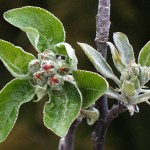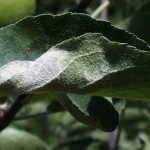Powdery mildew of apples is caused by the fungus Podosphaera leucotricha. Mildew can cause significant damage to many apple cultivars if trees are not protected with appropriate fungicides between tight cluster and first cover. Mildew infections on fruit cause russetting (Fig. 1). Most fruit infections occur between pink and petal fall. Furthermore, effective control of mildew on leaves is almost impossible if fungicide protection is delayed beyond petal fall. The best mildew control occurs when mildewcide programs are initiated at the tight cluster or pink bud stage.
Powdery mildew over-winters as mycelia in infected buds. When buds begin growing in spring, the mycelia in the infected buds colonize the new leaf and shoot tissue as it grows (Fig. 2). These “primary infections” become visible about the time trees reach tight cluster (Fig. 3). The powdery white deposits on leaves with primary infections consist of mycelia and conidia (Fig. 4). The conidia are wind-disseminated to new leaves where they cause secondary infections (fig. 5). (Secondary infections often begin appearing when trees are near petal fall, and they can become painfully obvious if trees are left unprotected until first cover. If left uncontrolled, the secondary infections colonize entire leaves along with the axillary or terminal buds that are formed during summer. Those infected buds then provide the inoculum for the next year.
Powdery mildew is often worse in years following mild winters and in years when the weather between bloom and petal fall is relatively dry with moderate temperatures. Winter temperatures below 10°F kill some of the over-wintering mildew in buds, and temperatures of –10°F will eliminate 95% of over-wintering mildew (Fig. 6). Dry springs favor mildew because, unlike most other fungi, powdery mildew does not require rainfall or dew for spore germination. Mildew conidia can germinate when relative humidity is above 70% (as commonly occurs at night or during early morning). Rainfall actually decreases the severity of mildew, both because spores germinate poorly in water and because rains wash conidia off of leaves. Optimum temperatures for conidial germination and infection are 68-72° F., but infection occurs readily at any temperature between 50 and 77° F.
Apple cultivars differ significantly in their susceptibility to powdery mildew. Braeburn, Cortland, Gala, Ginger Gold, Gravenstein, Idared, Jonathan, Mutsu, Paulared, Rome Beauty are all highly susceptible to powdery mildew whereas Delicious, Empire, and Fuji are much more resistant. Cultivars such as McIntosh and Golden Delicious can develop severe levels of secondary infection when they are planted adjacent to a highly-susceptible cultivar that supplies inoculum. Mildew-susceptible cultivars should be protected with fungicides that have activity against powdery mildew beginning no later than the pink-bud stage. On more resistant cultivars, starting mildew control at petal fall may provide adequate control.
- Fig. 1. Russetting on fruit caused by mildew infection
- Fig. 2. Primary infection showing leaves and fruit that were colonized by mycelia that over-wintered in the bud that produced them.
- Fig. 3. Primary mildew on a blossom cluster (right) as compared to a healthy cluster (left)
- Fig. 4. Close-up of a leaf with primary mildew showing the white mycelia and conidia coating the leaf surface
- Fig. 5. Leaf lesion caused by secondary mildew infection during summer
- Fig. 6. Mildewed shoot (right) that failed to develop new leaves because mildewed buds were killed during winter, as compared to a healthy shoot (left).
For more information:
Susceptibility of New Apple Cultivars to Common Apple Diseases
in N.Y. Fruit Quarterly (2003)
In Scaffolds Fruit Journal
2012 Controlling Apple Powdery Mildew After the Disease is Evident (download) /(web)
2005 Options for Controlling Powdery Mildew on Apples (download) /(web)
2000 Apple Disease Management at Petal Fall (download) /(web)
(Last updated 21 April 2014)






